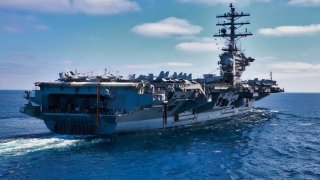China Faces the Exact 'Aircraft Carrier Nightmare' As U.S. Navy
China's military modernization has focused on developing anti-access/area-denial (A2/AD) systems to keep U.S. forces out of the Indo-Pacific, enabling Beijing to deploy its growing aircraft carrier fleet to dominate the region.
Summary and 3 Points You Need to Know: China's military modernization has focused on developing anti-access/area-denial (A2/AD) systems to keep U.S. forces out of the Indo-Pacific, enabling Beijing to deploy its growing aircraft carrier fleet to dominate the region.
-With three carriers, including the advanced Fujian, China aims to use these vessels as command centers in potential conflicts, particularly over Taiwan. As China's ambitions grow, so will its carrier fleet, posing a significant challenge to U.S. power projection.
-The U.S. should counter by establishing its own A2/AD defenses in the Western Hemisphere to deter Chinese expansion and protect American interests closer to home.
China’s Aircraft Carrier Fleet: A Growing Threat in the Indo-Pacific
China’s military has been on a modernization craze for over a decade. Beijing has done two interesting things in their drive to offset apparent U.S. military strengths. The first is to build a robust arsenal of anti-access/area-denial (A2/AD) weapons and spread those weapons throughout the Indo-Pacific.
In fact, China has invested heavily in more than just A2/AD. The world’s second-largest economy (in GDP terms) has built counterspace weapons, cyberwarfare capabilities, and other assets, all designed to do one thing: prevent the Americans from deploying forces into China’s near-abroad.
In other words, China has perfected a strategy of denial to their region.
What China Desires with Their Aircraft Carriers
Once China’s military has denied the American military access to the Indo-Pacific, Beijing plans to deploy its growing aircraft carrier fleet to bully its neighbors into submission.
The People’s Liberation Army Navy (PLAN) currently possesses three aircraft carriers. The first two carriers displace 60,000 tons and are based on old Soviet designs. The third carrier, the Fujian, displaces 80,000 tons and is indigenously designed and built by China.
What’s more, the Fujian incorporates new technologies. (Some of these, such as the electromagnetic catapult system – EMALS – were pilfered from the Americans via industrial espionage.) These new technologies have helped make the Fujian one of the most advanced carriers outside of the Western world.
Indeed, it makes China’s third carrier a significant power player in the region, and a real challenger to American and British designs.
The Fujian is not going to be the last advanced Chinese aircraft carrier.
In 2012, China’s now-disgraced former president, Hu Jintao, declared the People’s Republic of China will become a “great maritime power” in its own right. Presidents Hu and Xi Jinping may not have agreed on much. But on the matter of China evolving to become a dominant naval power in the Indo-Pacific, they certainly did concur.

Thanks to China’s massive manufacturing sector (which they have in part courtesy of greedy Wall Street-types and short-sighted Western politicians), they can create a fleet of these advanced boats. The question remains, however, in the era of A2/AD, how can the PLAN avoid the same complications that A2/AD poses to U.S. flattops from imperiling the PLAN’s own growing fleet of carriers?
Beijing’s logic is simple. With the Americans repelled by China’s denial systems, they will have free reign over the South China Sea, the East China Sea, and the Taiwan Strait.
They may even have dominance in the Yellow Sea and Sea of Japan, though that’s a harder sell, given South Korea’s military presence in the Yellow Sea and Japan’s presence in their eponymously named sea. And until the local governments deploy methods that could significantly threaten China’s growing aircraft carrier fleet, with the Americans pushed beyond the horizon, the PLAN thinks that it can rely upon its carrier fleet.
PLAN doctrine envisions their growing aircraft carrier fleet to be used as floating command centers. In any invasion of Taiwan, then, the carriers will be used to coordinate and command the overall invasion of the embattled island democracy.
America Should Build Its Own Regional A2/AD Defenses
Given these factors, the size and disposition of any Chinese aircraft carrier force would be contingent on the overall ambitions of China’s rulers.
Their fleet will grow as their ambitions increase.
What’s more, their fleet will grow relative to what they perceive to be the weakness of the U.S. fleet that will remain China’s primary global challenger. Interestingly, the Chinese may suddenly find themselves faced with problems that the U.S. carrier fleet currently finds itself facing in the Indo-Pacific, should the PLAN try to move beyond the third island chain in the Pacific and penetrate deeper into the waters of the Western Hemisphere.
Toward that end, Washington should take far more seriously the concept of hemispheric defense. Rather than building more expensive flattops, the U.S. military should start honeycombing the Western Hemisphere with a comprehensive network of its own A2/AD systems that can keep China’s growing aircraft carrier fleet just over the horizon.
One thing should be clear, though. China’s strategy of denial in their near-abroad, coupled with their mass production capabilities, are building a considerable military threat to the Americans. At some point, the Americans will find their traditional forms of power projection useless in regions closer to China’s shores.
Over time, too, the objectives of China’s force will shift considerably away from denying the U.S. military access to the Indo-Pacific, and toward penetrating waters nearer to the United States.
America’s military is primed only for expeditionary missions.
Soon, the United States will find itself living in a contested region, with Chinese warships prowling the waters just off America’s coast and throughout the Western Hemisphere. The time is now for the United States to start implementing a rapid plan of comprehensive hemispheric defense.
About the Author:
Brandon J. Weichert, a National Interest national security analyst, is a former Congressional staffer and geopolitical analyst who is a contributor at The Washington Times, the Asia Times, and The-Pipeline.
All images are Creative Commons and/or Shutterstock.


